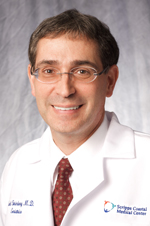Today SevenPonds chats with Dr. Karl Steinberg, MD. about his two-decade medical practice focusing on palliative and hospice care. Dr. Steinberg is the medical director of three nursing homes and Hospice by the Sea (since 1995). He currently sits on the board of directors at AMDA (American Medical Doctors Association) where he focuses on post-acute and long-term medicine. He also chairs the Coalition for Compassionate Care of California, which in his words is, “a great organization all about helping people make sure they get the kinds of treatment they want, and not get the kinds of treatment they don’t want.” Dr. Steinberg is also the editor-in-chief of a periodical AMDA puts out called Caring for the Ages.
Juniper: What inspired you to get into the field of long-term, post-acute, and palliative care and geriatrics? You’ve been working in these fields for about 20 years now.

Dr. Karl E. Steinberg, MD.
(Credit: scripps.org)
Dr. Steinberg: I didn’t train to specialize in geriatrics or do a fellowship in hospice and palliative medicine. I did a residency in family medicine and always found myself drawn to the elderly — especially older people with serious and chronic illnesses. I felt I had a knack for talking to those people, which some of my fellow colleagues didn’t share, and I found that the skill was really appreciated. When I first started my medical group, I inherited a mostly geriatric practice, and I started seeing patients in nursing homes.
Most people don’t like nursing homes, which have a bad reputation in the public eye, but I found I liked it because I didn’t have a waiting room full of people, and I could take as long as I wanted at the bedside. That’s a huge blessing. It’s hard to overestimate the value of that time you can take to talk to people. After I’d been at the group for a year or so we set up a nursing home team comprised of skilled nurses and custodial staff to make visits to various nursing homes and take on a lot of work that would normally fall to primary care doctors. Soon the team was serving about 20 nursing homes in San Diego county, seeing patients who had a primary doctor in our medical group.
One of the things I like about hospice work — I started working at Hospice by the Sea soon after my residency — is that it’s team-based care. When I meet a new patient who has been seeing the same primary care doctor for 10 or 15 years — a cardiologist or pulmonologist perhaps — I often find they’ve never once talked to their doctor about what their death might look like and how they’ll get from point A to point B. So I get to have those conversations with them. To this day, it’s one of the most rewarding parts of my career.
A lot of doctors don’t talk about death because they don’t want to bring up a subject that is perceived as negative, or have their patients lose hope. Or maybe they’ve got their own issues around death and dying, or they don’t have the time to have these conversations. When I’ve had these discussions with people they’re almost always super-grateful and really appreciate it.

Credit: rincondelrio.com
For example, I might have a conversation with someone about what CPR really is, and how most frail and/or elderly people wouldn’t survive or be severely impaired if they underwent that treatment. It’s not that you get a jolt and a couple of pumps and life is back to normal. In California we have the POLST form that includes a box saying “DNR” (Do Not Resuscitate) or, in the new language we’re using now, AND (Allow Natural Death). But people don’t want to check that box because they think it means, “If I’m flailing around and have shortness of breath, just let me die.” DNRs/ANDs don’t work like that — they only come into effect if you have no pulse and aren’t breathing. So it someone is short of breath or has an irregular heartbeat, [the medical community] will do what they can to correct that. So with this POLST form, I can fill it out with a client for them to take home and put on their fridge, so that when the paramedics come if they have an event, they’re not going to be put through something they don’t want.
Juniper: Do you find that a majority of your patients would not have completed POLST forms if they hadn’t happened to land in front of you? Is advanced care planning not something that family doctors do with their elderly and/or terminally ill patients as a rule? Is this conversation not a standard in the medical industry?
Dr. Steinberg: The short answer is yes: most family doctors don’t cover this material with their patients. Neither do specialists — especially oncologists, who are taking care of people who are dying of, for example, stage four metastatic cancer.

Credit: 50plusmarketplacenews.com
Juniper: Is this because they assume that social workers would be taking on the role of sorting out advanced care planning with a patient? Is this conversation with a social worker accessible to the majority of your patients?
Dr. Steinberg: The details needed in that conversation for patients to make informed choices are often not accessible to them because — and perhaps I’m a little biased here — a doctor is in the best position to explain the details of specific medical interventions (CPR, feeding tubes, intubation and mechanical ventilation, etc.). I would support any professional willing to have these conversations as long as they’re providing accurate and appropriate information. In palliative care you’re already working with a team that includes a social worker and spiritual advisor. Any of these people could be educated to have these conversations with patients, but I think ultimately, a doctor has a relationship with a patient that makes them the natural first person for having them.
Interested in learning more? Come back next week for part two of our interview.

 What is a Doctor’s Role in Advance Care Planning? An Interview with Dr. Karl Steinberg, MD: Part One
What is a Doctor’s Role in Advance Care Planning? An Interview with Dr. Karl Steinberg, MD: Part One


 John Mulaney’s “Funeral Planning” on Netflix: No Real Plan
John Mulaney’s “Funeral Planning” on Netflix: No Real Plan

 Composting Bodies Is Now Legal in a Dozen States
Composting Bodies Is Now Legal in a Dozen States














